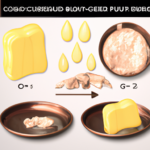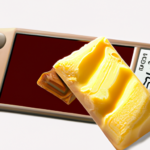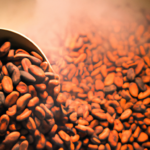Raw Food Ingredients
Why Does Chocolate Melt in Your Mouth?
Wondering why chocolate melts in your mouth? Discover the fascinating science behind this delectable phenomenon and satisfy your curiosity.
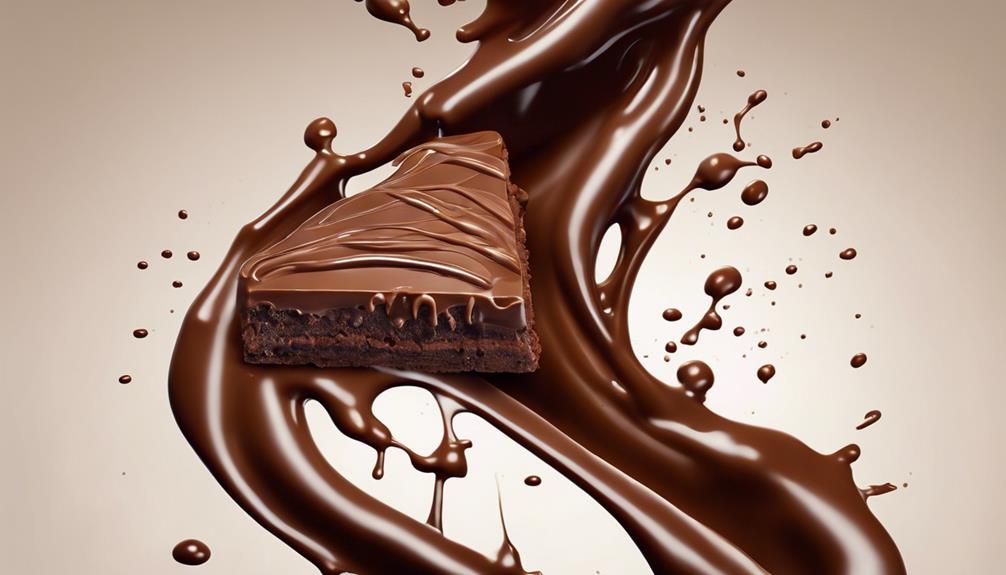
Chocolate dissolves in your mouth due to its critical melting point, usually ranging from 86 to 90 degrees Fahrenheit, which enables it to effortlessly melt at your body’s warmth. Cocoa butter, found in chocolate, melts slightly below body temperature, impacting its consistency and mouthfeel. The tempering procedure, crucial for attaining the intended crystal structures in chocolate, additionally plays a role in its silkiness and richness. Recognizing these elements can enhance your understanding of why chocolate tantalizingly melts on your taste buds.
Key Takeaways
- Chocolate has a low melting point close to body temperature.
- Cocoa butter's structure and fatty acids influence chocolate's melting properties.
- Proper tempering creates specific crystal forms for smooth texture.
- Milk fat content affects texture, melting speed, and mouthfeel.
- Additives like emulsifiers impact melting speed and mouthfeel.
Chocolates Low Melting Point
Exploring why chocolate swiftly melts in the mouth reveals the fascinating science behind its low melting point. Chocolate's melting point typically ranges from 86 to 90 degrees Fahrenheit, allowing it to dissolve quickly on your tongue.
This rapid melting sensation is due to the cocoa butter content in chocolate. Cocoa butter, a key component of cacao beans, melts at approximately 93°F. The creamy texture of chocolate is a result of this cocoa butter, which constitutes around 50% of the bean.
The amount of cocoa fats, cocoa solids, milk fat, and additives in chocolate can also influence its melting speed and mouthfeel. Even though the human body temperature might be cooling to 97.9°F, it still remains higher than chocolate's melting point, ensuring that this delectable treat melts effortlessly in your mouth.
Understanding the dynamics of chocolate's low melting point and cocoa butter content can enhance your appreciation of its delightful texture and flavor.
The Role of Cocoa Butter
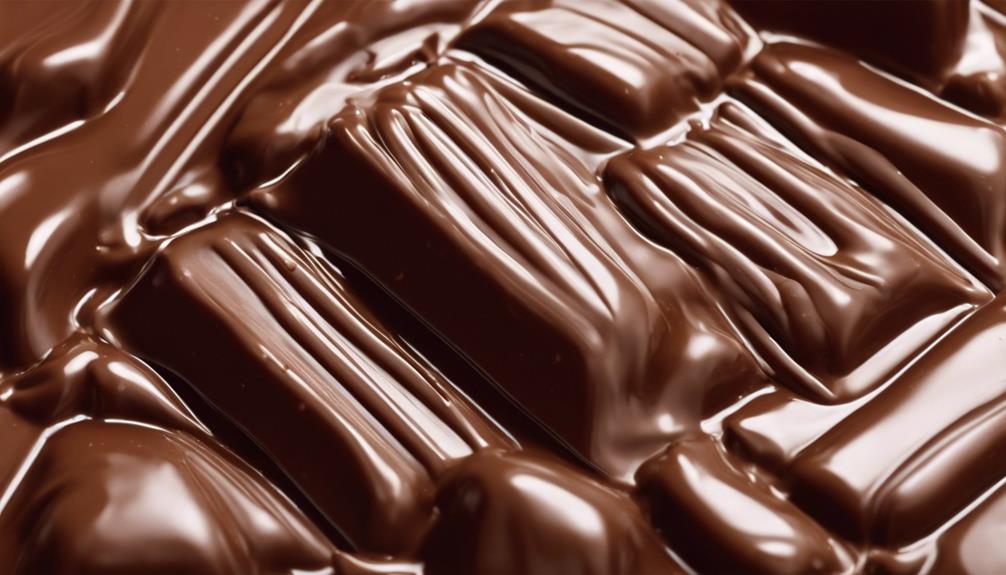
Cocoa butter, a significant component in chocolate, is responsible for its unique melting characteristics. This natural fat has a melting point slightly below our body temperature, allowing it to melt smoothly in our mouths.
The composition of different fatty acids in cocoa butter influences how quickly and evenly the chocolate melts, affecting its overall texture and mouthfeel.
Cocoa Butter Structure
The composition of cocoa butter in chocolate greatly influences its texture and mouthfeel. Cocoa butter, made up of palmitic, stearic, and oleic acids, determines the structure of chocolate. This unique blend of fatty acids plays an important role in creating that smooth, creamy sensation when chocolate melts in your mouth.
The melting point of cocoa butter, around 93°F, is lower than our body temperature, ensuring that chocolate melts effortlessly on the tongue. Adjusting the ratio of cocoa butter can impact glossiness, snap, and overall quality. Genetic factors also affect cocoa butter's melting point, making proper tempering essential for achieving the desired crystal forms that give chocolate its perfect texture and mouthfeel.
Melting Point Explanation
As a key component in chocolate, cocoa butter's melting point at 93°F plays an essential role in creating its unique texture and mouthfeel.
- Cocoa butter contains palmitic, stearic, and oleic acids, influencing the melting properties of chocolate.
- The genetic makeup of cocoa beans can impact the melting point of cocoa butter, affecting the overall texture of chocolate.
- Adjusting the ratio of cocoa butter in chocolate allows chocolatiers to control the desired melting point for specific products.
- Tempering chocolate, a controlled heating and cooling process, helps create the desired crystal forms of cocoa butter for a glossy appearance and proper texture.
Impact of Tempering Process
When we temper chocolate, we're not just making it look pretty. The process actually affects how the chocolate feels in your mouth. By controlling the crystal structure, we can manipulate the chocolate's texture and melting point, giving it that perfect melt-in-your-mouth quality.
Tempering Affects Texture
In understanding the impact of tempering on texture, one must grasp the intricate process of controlled heating and cooling in chocolate production.
- Tempering chocolate involves creating specific crystal forms in cocoa butter.
- The tempering process affects the texture, gloss, and snap of chocolate.
- Proper tempering guarantees a desired crystalline structure for smooth and creamy chocolate.
- Different crystal forms of cocoa butter melt at precise temperatures, influencing the mouthfeel of chocolate.
Mastering the tempering process is essential for achieving the perfect texture and mouthfeel in chocolate. It's fascinating how something as precise as controlling the heating and cooling of chocolate can make all the difference in the final product's quality.
Crystal Structure Formation
Creating the perfect crystal structure in chocolate through the tempering process is essential for achieving the desired texture and mouthfeel. The tempering process helps cocoa butter molecules form stable crystal structures, including the sought-after β (beta-5) polymorph, ensuring high-quality chocolate. By controlling the heating and cooling stages during tempering, the cocoa butter aligns in a stable configuration, influencing the chocolate's smoothness and snap when consumed. Different crystal forms of cocoa butter melt at specific temperatures, impacting the overall mouthfeel and texture of the chocolate. Understanding how tempering affects crystal structure formation is vital for producing excellent chocolate that melts smoothly in your mouth.
| Crystal Forms | Cocoa Butter |
|---|---|
| β (beta-5) polymorph | Stable Configuration |
| Smooth Texture | Creamy Mouthfeel |
Melting Point Manipulation
To achieve the desired smooth texture and glossy appearance of chocolate, manipulating the melting point through the tempering process is essential. When working with chocolate, understanding how tempering impacts the crystalline structure is vital for creating a delightful mouthfeel.
Here are some key points to keep in mind:
- Proper tempering guarantees the cocoa butter crystals are in the stable form for that perfect melt-in-your-mouth experience.
- The different crystal forms of cocoa butter melt at specific temperatures, impacting the overall texture and taste in your mouth.
- Through tempering, the microstructure of the chocolate is optimized, resulting in a creamy and enjoyable melting sensation.
- Controlling the melting point during tempering is the key to achieving that glossy appearance and smooth texture that we all love in chocolate.
Influence of Milk Fat Content
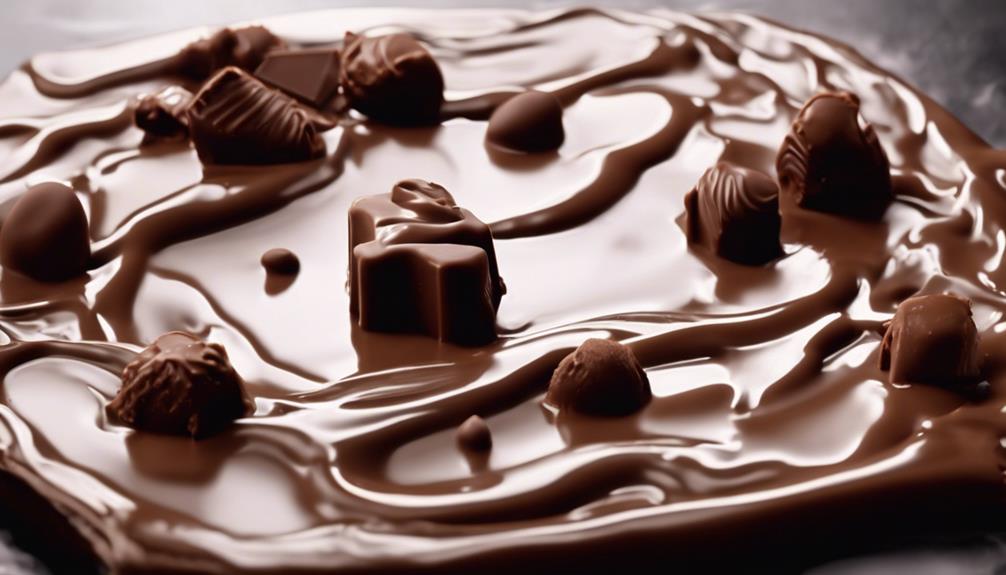
Changing the milk fat content in chocolate significantly impacts its texture, melting speed, and overall mouthfeel. When the milk fat content is higher, the chocolate tends to have a creamier texture and melts more slowly in your mouth. This richness and smoothness are due to the presence of more milk fat. On the other hand, chocolate with lower milk fat content may melt faster and offer a different mouthfeel experience. By adjusting the milk fat content, chocolatiers can play with the texture and flavor of the chocolate, creating unique combinations that appeal to different preferences.
To illustrate the impact of milk fat content on chocolate, let's take a look at this table:
| Milk Fat Content | Texture | Melting Speed |
|---|---|---|
| Higher | Creamier | Slower |
| Lower | Different | Faster |
Experimenting with the milk fat content can lead to a world of chocolate variations, each offering a distinct texture and melting experience.
Additives and Melting Speed
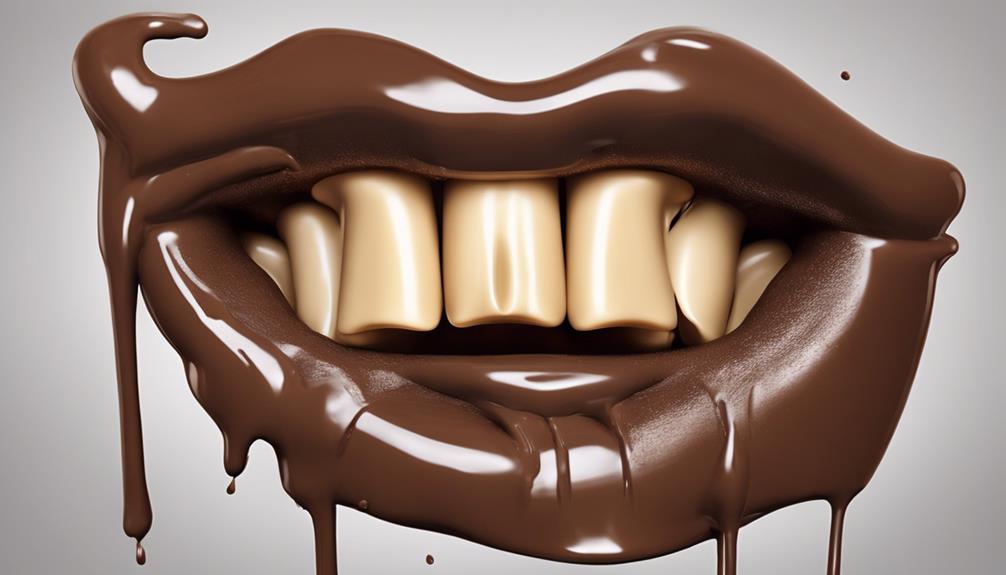
Additives such as milk fat and emulsifiers play a crucial role in speeding up the melting process of chocolate. Milk fat, with its unique makeup, helps decrease the melting point of chocolate, causing it to melt more rapidly in your mouth. Emulsifiers, on the other hand, contribute to producing a silkier texture in chocolate, which further enhances faster melting. Understanding how these additives influence the melting speed can greatly help in refining chocolate formulation for ideal outcomes.
- Milk fats in chocolate decrease the melting point due to their composition.
- Emulsifiers aid in creating a silkier texture in chocolate, encouraging faster melting.
- The combination of additives and cocoa butter affects the overall mouthfeel and melting properties of chocolate.
- Recognizing the impact of additives on melting speed can assist in chocolate formulation.
Factors Affecting Mouthfeel
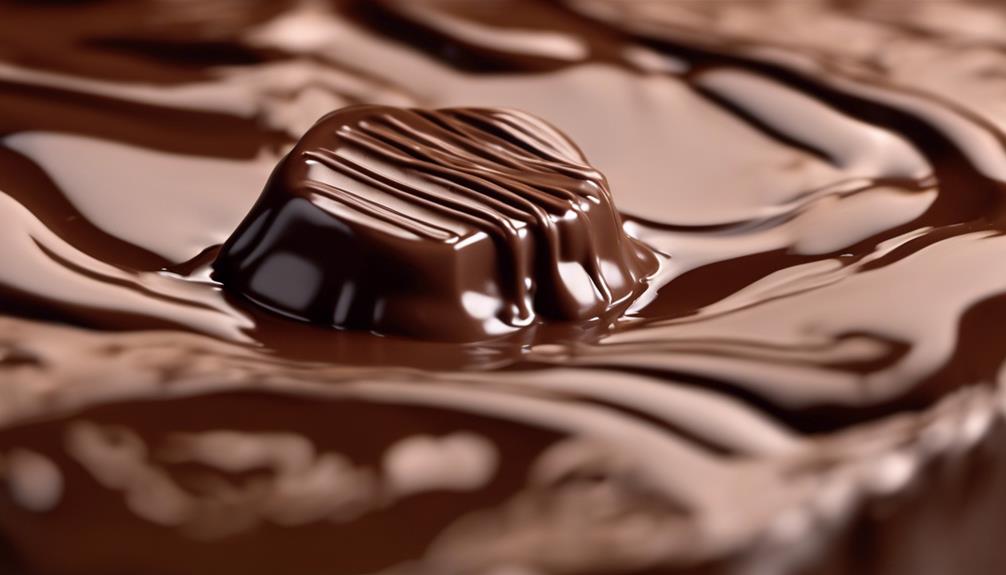
The texture of chocolate and its melting characteristics are directly influenced by the structural arrangement within the chocolate itself. Research in the science of chocolate has shown that the amount and type of fat present play an important role in what makes chocolate melt so well in our mouths, creating that delicious sensation. Understanding the process behind how chocolate melts can lead to a more enjoyable eating experience.
To explore further into the factors affecting mouthfeel, let's examine the table below:
| Factors | Effects |
|---|---|
| Compact Structure | Slower melting, creamier mouthfeel |
| Open Structure | Faster melting, smoother mouthfeel |
| Proper Tempering | Smooth and creamy texture enhancement |
| Improper Tempering | Grainy mouthfeel due to uneven particle distribution |
Frequently Asked Questions
What Happens When You Put Chocolate in Your Mouth?
When I put chocolate in my mouth, it melts due to the cocoa butter's low melting point. The smooth sensation comes from the chocolate reaching its melting range of 86-90°F. Additives and milk fat can affect how quickly it dissolves.
What Chocolate Melts in Your Mouth but Not in Your Hand?
M&M's chocolate candy melts in my mouth but not in my hand. Its candy shell protects the chocolate inside, made with sugar, corn syrup, and colors. The shell's design keeps it from melting, making M&M's a convenient treat.
Are You Supposed to Let Dark Chocolate Melt in Your Mouth?
Should dark chocolate melt in your mouth? Absolutely. Letting it slowly dissolve enhances the rich flavors and textures. As it melts, the velvety cocoa goodness intensifies, creating a truly decadent experience for your taste buds.
Why Does Chocolate Melt in a Person's Hand?
Chocolate melts in my hand because its melting point is lower than body temperature. The milk fat and additives in chocolate influence how quickly it melts. Cocoa butter, melting at 93°F, also aids in the process.
Does the Tempering Process Affect How Chocolate Melts in Your Mouth?
When it comes to how chocolate melts in your mouth, the tempered vs untempered chocolate differences play a significant role. Tempered chocolate melts smoothly, with a glossy finish and satisfying snap, whereas untempered chocolate can feel greasy and not melt evenly. The tempering process definitely affects the mouthfeel of chocolate.
Conclusion
So, next time you enjoy a piece of chocolate, think about why it melts in your mouth. The low melting point of chocolate, the role of cocoa butter, the impact of tempering process, the influence of milk fat content, and additives all play a part.
But do you know what makes chocolate taste so good when it melts? Maybe it's the perfect combination of sweetness and creaminess that makes it irresistible.
Rachael, the Editor in Chief of RachaelsRawFood.com, is an inspiring and passionate individual who has dedicated her life to promoting the benefits of a raw food lifestyle. Known for her vibrant and energetic personality, Rachael has built a strong online presence that has transformed her personal journey into a thriving community of raw food enthusiasts.
Raw Food Ingredients
How Much Caffeine in Cocoa?
Not all cocoa products are created equal when it comes to caffeine content – discover which one might surprise you!

When evaluating the caffeine levels in cocoa, it’s important to recognize that dark chocolate contains around 43 mg of caffeine per 100 grams due to its high cocoa solid content. Dark chocolate has a higher caffeine content compared to milk or white chocolate. This means that consuming dark chocolate in moderation can assist in managing your caffeine intake. On the other hand, milk chocolate has around 20 mg of caffeine per 100 grams while white chocolate is caffeine-free. Cocoa powder, commonly used in baking and beverages, contains a substantial 230 mg of caffeine per 100 grams. Being aware of these distinctions in chocolates can help you make informed decisions about your caffeine consumption.
Key Takeaways
- Caffeine content in cocoa varies based on cocoa solid concentrations.
- Unsweetened cocoa powder can contain around 230 mg of caffeine per 100 grams.
- Roasting cocoa solids influences the final caffeine content in cocoa products.
- Dark chocolate, with high cocoa solid content, has more caffeine than milk chocolate.
- Moderate consumption of cocoa products helps manage caffeine intake.
Caffeine Content in Dark Chocolate
Dark chocolate boasts a caffeine content of approximately 43 mg per 100 grams, mainly deriving from its higher cocoa solid composition. When we indulge in this decadent treat, we aren't only savoring its rich cocoa flavor but also a subtle caffeine kick. Compared to milk or white chocolate, dark chocolate contains a higher amount of caffeine.
Please bear in mind that moderate consumption of dark chocolate can assist individuals in managing their caffeine intake effectively. The caffeine levels in dark chocolate are about one-fourth of what you'd find in a standard cup of coffee. So, if you're looking for a milder caffeine boost, a piece of dark chocolate might just do the trick without the jitters that sometimes accompany a strong cup of coffee.
Enjoy your dark chocolate in moderation, savoring both its taste and the gentle pick-me-up it provides.
Caffeine Levels in Milk Chocolate

Milk chocolate, known for its creamy texture and sweet flavor, contains a modest caffeine content of approximately 5.6 mg per ounce, as indicated by USDA data. Unlike dark chocolate, milk chocolate has a lighter color due to lower cocoa content, resulting in reduced caffeine levels.
The delightful creamy taste in milk chocolate comes from a harmonious blend of cocoa and milk powder. While dark chocolate boasts higher caffeine content, milk chocolate remains a popular choice for those seeking a sweet treat with minimal caffeine intake.
Caffeine Presence in White Chocolate
With its unique composition excluding cocoa solids, white chocolate stands out as a caffeine-free alternative to its darker counterparts. White chocolate is crafted from a blend of cocoa butter, milk powder, sugar, and vanilla, making it a delectable treat without the stimulating effects of caffeine. For individuals sensitive to caffeine, white chocolate offers a creamy texture and indulgent flavor without the worry of unwanted side effects. This makes it a popular choice for desserts among those looking to steer clear of caffeine in their sweet treats.
Compared to dark chocolate, which contains cocoa solids and hence caffeine, white chocolate provides a caffeine-free option for those seeking a more mellow indulgence. So, if you're in the mood for a luscious and smooth chocolate experience without the buzz of caffeine, white chocolate is the perfect choice for your next dessert delight.
Impact of Cocoa Solids on Caffeine

In determining the caffeine levels in cocoa products, the percentage of cocoa solids plays a significant role. Here are some key points about the impact of cocoa solids on caffeine content:
- Caffeine Derivation: The caffeine content in cocoa primarily comes from cocoa solids, making it an important factor in determining the overall caffeine levels in cocoa-based products.
- Dark Chocolate: Dark chocolate, known for its higher cocoa solid content, tends to contain more caffeine compared to milk or white chocolate varieties due to this higher concentration.
- Unsweetened Cocoa Powder: A 100g serving of unsweetened cocoa powder can contain around 230mg of caffeine, reflecting the impact of the high cocoa solid content in this form.
- Health Benefits: The roasting process of cocoa solids not only affects the flavor profile but also influences the caffeine content, contributing to the potential health benefits associated with consuming cocoa products like hot cocoa.
Comparing Caffeine in Different Chocolates
Comparing the caffeine content in different chocolates reveals varying levels based on their cocoa solid concentrations. Dark chocolate contains about 43 mg of caffeine per 100 grams, making it a stronger caffeinated option compared to milk chocolate, which only has around 20 mg per 100 grams.
Surprisingly, white chocolate, derived from cocoa butter, doesn't contain any caffeine at all. For those seeking a more potent caffeine kick, cocoa powder is the way to go, boasting a high concentration of 230 mg per 100 grams.
The amount of caffeine in chocolate products is closely linked to the cocoa solid content, with dark chocolate containing the highest levels. So, the next time you're craving a chocolate treat but also need a little energy boost, opt for dark chocolate to get the most caffeine per bite.
Frequently Asked Questions
Is There More Caffeine in Cocoa Than Coffee?
There's more caffeine in cocoa than in coffee. Cocoa powder packs 230 mg per 100 grams, surpassing most coffee varieties. Dark chocolate has even more caffeine due to higher cocoa content. It's a rich, unique energy source.
Is There a Lot of Caffeine in Hot Cocoa?
There isn't a lot of caffeine in hot cocoa. It depends on the brand and recipe. Starbucks hot chocolate has around 25 mg per serving, while basic mixes have about 5 mg. The amount of cocoa powder used influences the caffeine content.
Is There Caffeine in Hershey's Cocoa?
Absolutely, Hershey's Cocoa does contain caffeine, but it's not overwhelming. It adds a delightful hint of energy in each spoonful. Perfect for baking or a cozy cup of hot chocolate. Just the right amount!
Is Cocoa a Stimulant Like Caffeine?
Cocoa stimulates like caffeine due to its theobromine content. Decaf versions offer a solution for caffeine-sensitive folks. Options include regular cocoa with caffeine, Dutch-processed cocoa with less, and decaf cocoa with reduced caffeine while keeping healthful compounds.
What are the potential health effects of consuming high levels of caffeine in cocoa?
Unveiling cocoa caffeine levels can lead to potential health effects of excessive consumption. High levels of caffeine in cocoa may contribute to insomnia, nervousness, and fast heartbeat. It can also cause gastrointestinal discomfort and exacerbate anxiety disorders. Moderation in consuming caffeinated cocoa products is recommended for overall health.
Conclusion
To sum up, the caffeine content in cocoa varies depending on the type of chocolate. Dark chocolate typically has the highest caffeine levels, followed by milk chocolate and white chocolate. The amount of cocoa solids in the chocolate also affects the caffeine content.
Remember, just like different chocolates have different levels of caffeine, we all have unique strengths and abilities. Embrace your individuality and always aim for balance in everything you do.
Rachael, the Editor in Chief of RachaelsRawFood.com, is an inspiring and passionate individual who has dedicated her life to promoting the benefits of a raw food lifestyle. Known for her vibrant and energetic personality, Rachael has built a strong online presence that has transformed her personal journey into a thriving community of raw food enthusiasts.
Raw Food Ingredients
5 Key Differences: Caffeine Content in Cocoa Vs Coffee
Open the door to understanding the contrasting caffeine levels in cocoa and coffee, revealing surprising insights that will reshape your beverage choices.

When comparing the caffeine levels in cocoa and coffee, it is important to understand that cocoa generally has lower caffeine content than coffee. Dark chocolate contains approximately 12 milligrams of caffeine per ounce, while hot cocoa typically ranges from 5 to 10 milligrams per ounce. In contrast, brewed coffee can have significantly higher levels, varying from 95 to 165 milligrams per 8-ounce cup.
Cocoa is considered a milder option for individuals aiming to limit their caffeine intake, with theobromine providing a gradual energy increase. Meanwhile, coffee's caffeine content offers immediate alertness, and understanding these distinctions can help you select based on your preferred effects.
Key Takeaways
- Cocoa contains lower caffeine levels but compensates with theobromine for a gradual energy increase.
- Coffee has higher caffeine content, offering an immediate alertness boost and potentially higher metabolic rate.
- Theobromine in cocoa promotes relaxation, while caffeine in coffee provides intense alertness and mood fluctuations.
- Hot chocolate is a good option for reducing caffeine intake while still benefiting from theobromine effects.
- Understanding caffeine variances helps make informed choices for desired energy levels and mood effects.
Caffeine Levels in Cocoa Vs Coffee
When comparing caffeine levels in cocoa versus coffee, it's evident that cocoa generally contains lower amounts per serving. Dark chocolate, made from cacao beans, contains around 12 milligrams of caffeine per ounce, while a 1-ounce serving of hot cocoa mix typically has 5-10 milligrams. Even a 16-ounce serving of Starbucks hot chocolate only contains about 25 milligrams of caffeine.
On the other hand, coffee, when brewed, can range from 95 to 165 milligrams of caffeine per 8-ounce cup, depending on the type and brewing method. This significant difference in caffeine content between cocoa and coffee makes cocoa a milder option for those looking to limit their caffeine intake.
Impact on Alertness and Energy

Typically, the immediate alertness and energy boost from caffeine in coffee can last for hours. This surge in alertness is due to caffeine's stimulating effect on the central nervous system. On the other hand, cocoa contains theobromine, which provides a more gradual increase in energy levels. Unlike caffeine, theobromine doesn't cause sudden spikes and crashes, offering a smoother energy curve.
Coffee's caffeine content can temporarily boost the metabolic rate, potentially supporting weight management efforts. This increased metabolic rate can aid in burning calories and may contribute to weight loss when combined with a balanced diet and regular exercise. Additionally, theobromine in cocoa contributes to the thermogenic effect, leading to mild calorie burning in the body.
Both caffeine and theobromine can influence mood. Caffeine tends to provide a more intense and quick-acting mood elevation, while theobromine promotes feelings of relaxation and contentment. Understanding the differences in alertness, energy, metabolic effects, and mood enhancements between cocoa and coffee can help individuals make informed choices based on their preferences and wellness goals.
Metabolic Variances and Effects
Regarding metabolic variances and effects, the varying caffeine levels between cocoa and coffee play a significant role. When comparing the metabolic impact of caffeine in cocoa and coffee, it is crucial to note that cocoa contains lower levels of caffeine but compensates with theobromine, which aids in the thermogenic effect, promoting calorie burning and metabolic activity. On the other hand, coffee, especially brewed varieties, contains higher levels of caffeine, potentially providing a temporary boost to the metabolic rate, which could assist in weight management. While caffeine in coffee offers a quick energy surge, theobromine in cocoa leads to a more gradual rise in energy levels, avoiding sudden spikes and crashes. To summarize the metabolic differences, I've created a table below:
| Aspect | Cocoa | Coffee |
|---|---|---|
| Caffeine Content | Lower levels | Higher levels |
| Additional Component | Theobromine | Caffeine |
| Metabolic Impact | Thermogenic effect | Temporary metabolic rate boost |
| Energy Levels | Gradual rise | Quick surge |
| Weight Management | Aids in calorie burning | Potential assistance |
Mood Enhancement Disparities

In comparing the mood enhancement effects of theobromine in cocoa and caffeine in coffee, notable disparities emerge in their impact on mental well-being.
The theobromine found in cocoa promotes relaxation and contentment, offering a gradual rise in energy levels that leads to a gentle and long-lasting mood enhancement experience.
On the other hand, caffeine delivers an intense and fast-acting boost in alertness, providing immediate energy levels that can lead to abrupt spikes and crashes.
While both theobromine and caffeine uplift mood, theobromine's effects are characterized by a steady and gradual increase in energy levels, creating a sense of calm and contentment.
In contrast, caffeine's impact is more intense and temporary, resulting in rapid alertness but also the potential for fluctuations in mood. Understanding these differences can help individuals choose between cocoa and coffee based on their desired mood enhancement effects.
Health Implications and Considerations
Health implications and considerations surrounding caffeine consumption warrant close attention due to its potential impact on various aspects of well-being. When comparing a cup of coffee to hot chocolate, it's vital to note the amount of caffeine present.
While coffee contains much caffeine, hot chocolate has less caffeine but isn't entirely devoid of it. The main active ingredients in hot chocolate are theobromine and caffeine, where theobromine is a relative of caffeine and also has stimulant effects, although milder. If you're looking to reduce your caffeine intake, opting for hot chocolate over a cup of coffee can be a good choice.
Being mindful of the caffeine content in chocolate products is important, especially if you're sensitive to caffeine or belong to vulnerable populations like children or pregnant women. Understanding the caffeine levels in different beverages allows you to make informed decisions about your consumption for better overall health.
Frequently Asked Questions
Is There Caffeine in Coffee Vs Cacao Powder?
Yes, there is caffeine in coffee, with around 140 milligrams in a 12-ounce cup. On the other hand, cacao powder contains only about 12 milligrams per tablespoon, making it a great caffeine-free alternative for those seeking a milder boost.
What Is the Difference Between Cocoa and Coffee?
When comparing cocoa and coffee, cocoa offers a rich, chocolatey flavor and is packed with antioxidants and minerals. Coffee, on the other hand, provides a robust, bitter taste and a jolt of caffeine for that morning pick-me-up.
Why Is Cocoa Better Than Coffee?
I believe cocoa is superior to coffee because it offers a gentler energy boost, promotes relaxation and contentment, and provides sustained vitality without sudden crashes. Plus, dark chocolate's theobromine supports cellular health and tastes delicious.
How Much Caffeine Is in Cocoa Powder Vs Decaf Coffee?
In cocoa powder vs decaf coffee, cocoa has 12-26mg of caffeine per tbsp, while decaf coffee holds 2-5mg per 8-ounce cup. The choice hinges on desired caffeine levels and flavor. I prefer cocoa's lower caffeine content.
How does the caffeine content in hot chocolate compare to coffee?
Hot chocolate caffeine content is significantly lower than that of coffee. While an 8-ounce cup of hot chocolate contains about 5-10 milligrams of caffeine, the same size of coffee can have anywhere from 95-200 milligrams. It’s a notable difference for those looking to limit their caffeine intake.
Conclusion
To sum up, while cocoa and coffee both contain caffeine, the levels vary significantly. Cocoa generally has lower caffeine content compared to coffee, impacting alertness, energy levels, and mood enhancement differently.
It's crucial to keep these differences in mind when choosing between the two beverages for your daily consumption. Remember, moderation is key to maintaining a healthy balance in your caffeine intake.
So, whether you prefer a cup of cocoa or a mug of coffee, enjoy it in moderation for the best benefits!
Rachael, the Editor in Chief of RachaelsRawFood.com, is an inspiring and passionate individual who has dedicated her life to promoting the benefits of a raw food lifestyle. Known for her vibrant and energetic personality, Rachael has built a strong online presence that has transformed her personal journey into a thriving community of raw food enthusiasts.
Raw Food Ingredients
A Guide to Becoming a Good King
Kingship demands wisdom, fairness, integrity, courage, and humility – essential traits for a successful reign and prosperous kingdom." Keep reading to uncover the secrets of becoming a good king.

In order to be a good king, one must embody wisdom, fairness, integrity, courage, and humility to lead the kingdom with honor. Wisdom is essential for making important decisions, fairness ensures just treatment for all, integrity builds trust and respect, courage is crucial for facing challenges, and humility reminds us of our humanity. Historical kings such as Solomon, Arthur, David, Charlemagne, and Ramses II serve as role models for these leadership traits.
As a king, embracing challenges, understanding the world, seeking personal growth, and learning from the past are essential responsibilities. Developing leadership skills, making wise decisions, and prioritizing the well-being of the people are key to effective kingship. Every step on the path to becoming a good king is critical for a successful reign and prosperous kingdom.
Key Takeaways
- Embrace wisdom for informed decisions.
- Practice fairness for just treatment.
- Uphold integrity to earn trust.
- Show courage in facing challenges.
- Maintain humility for empathy and respect.
Qualities of a Good King
Being a good king requires embodying qualities such as wisdom, fairness, integrity, courage, humility, and compassion in decision-making and leadership. Power comes with responsibility, and as a king, it's essential to wield this power wisely. Wisdom is vital in making sound judgments that benefit the kingdom as a whole. Fairness guarantees that all subjects are treated justly and equitably, fostering a harmonious society. Integrity is the foundation of trust and respect, key elements in effective leadership.
Courage is necessary to face challenges and make difficult decisions, even when met with opposition. Humility reminds a king of his humanity and the importance of humility in interactions with all subjects. Compassion demonstrates a king's care and empathy towards his people, fostering a sense of unity and loyalty. Effective communication is crucial for conveying decisions, listening to concerns, and inspiring confidence in leadership.
Historical Kings as Role Models

King Solomon, renowned for his wisdom and leadership, stands as an exemplar among historical kings who serve as role models for future leaders. Looking at figures like King Arthur, known for his justice and valor in medieval legends, and King David, celebrated for his faith and courage in battle, we find lessons that transcend time. Charlemagne's legacy of military conquests and cultural revival, alongside Ramses II's grand building projects and military campaigns, offer diverse insights into effective kingship. Below is a table summarizing key attributes of these historical kings:
| King | Attributes |
|---|---|
| King Solomon | Wisdom, leadership |
| King Arthur | Justice, valor |
| King David | Faith, courage |
| Charlemagne | Military prowess, culture revival |
| Ramses II | Building projects, military campaigns |
Studying these historical figures can provide valuable lessons on the multifaceted qualities that make a great ruler.
Responsibilities of Kingship
Embracing challenges and living authentically are central to fulfilling the responsibilities inherent in kingship. As men aspiring to be good kings, it's essential for us to understand that the world requires leaders who are kind, humble, and committed to personal growth.
The journey to becoming a good king involves more than just wielding power and responsibility—it entails sacrificing comfort for growth and transformation. Seeking the ancient path of masculinity, as exemplified by figures like Morgan, teaches us the importance of humility, vulnerability, and character development.
In fulfilling the responsibilities of kingship, we're entrusted with power not for our own gain, but for the betterment of the world around us. Just as seeds need Good Soil to flourish, we must nurture our own growth to lead effectively.
Leadership Skills for Kings

Developing essential leadership skills is crucial for aspiring kings seeking to fulfill their responsibilities with humility, vulnerability, and a focus on character development. As you study the world around us, the power and responsibility of what kingship entails become clearer. Here are some key points to think about on your path to becoming a king:
- Embrace challenges and live authentically.
- Seek ancient paths of masculinity for guidance.
- Reflect on your identity, purpose, and ability to be entrusted with power for good.
- Sacrifice comfort for growth, transformation, and participation in universal creativity.
The journey of becoming a king isn't just about gaining authority but about understanding the remarkable fellowship of like-hearted individuals who share similar goals. Engage in group discussion questions, consider between-session personal study, and explore the depths of your masculine soul. This is the path to restoring what it means to be a true king.
Importance of Wise Decision-Making
Steering through the intricacies of leadership, especially in the domain of kingship, requires a sharp focus on the art of prudent decision-making. Wise decision-making is like the compass guiding the ship of leadership towards success.
Good kings understand that their choices impact not just themselves but also the lives of those they rule over. They prioritize the well-being of their people over personal gains, embodying the essence of true leadership.
Seeking counsel from trusted advisors and reflecting on core values are essential practices in the domain of wise decision-making. By embracing humility and self-awareness, kings can navigate the complex web of choices with clarity and integrity.
Just like a six-session video Bible study can guide individuals in restoring the heart, wise decision-making is essential for becoming the kind of leaders our world needs. Let's start on this journey of radical reconstruction, where every decision is a step towards being counted among the good kings of history.
Frequently Asked Questions
What Is the Becoming a King Guide?
The Becoming a King guide is a transformative resource created by Morgan Snyder to help men grow into responsible kings. It offers practical tools and profound insights to aid personal development and transformation.
What Are the Qualities of a Good King?
Being a good king means embodying humility, wisdom, and integrity. Prioritizing the well-being of my people, making decisions for the greater good, and showing courage, justice, and compassion in all actions. Seeking counsel and valuing diverse perspectives is essential.
What Makes a True King?
Beneath the crown lies a heart that beats with humility and a spirit that soars with honor. True kings are forged in the fires of challenge, embracing authenticity and growth to inspire others.
What Makes a Real King?
Being a true king means embodying humility, courage, and empathy. It's about serving others and leading with integrity. I endeavor to cultivate these qualities daily, embracing challenges and seeking growth in all aspects of my life.
How Can Sacred Cacao be Incorporated Into Kingship Rituals?
In kingship rituals, the sacred cacao ritual holds great significance. The ceremonial drinking of cacao symbolizes the divine connection between the ruler and the spiritual realm. It is believed to impart wisdom and strength, making it a crucial element in the coronation and leadership rites of many cultures.
Conclusion
To sum up, becoming a good king requires a combination of qualities, skills, and responsibilities. Remember, 'With great power comes great responsibility.'
By studying historical kings as role models, practicing leadership skills, and making wise decisions, one can aspire to be a just and effective ruler.
It's a challenging path, but with dedication and perseverance, anyone can endeavor to be a worthy leader for their kingdom.
Rachael, the Editor in Chief of RachaelsRawFood.com, is an inspiring and passionate individual who has dedicated her life to promoting the benefits of a raw food lifestyle. Known for her vibrant and energetic personality, Rachael has built a strong online presence that has transformed her personal journey into a thriving community of raw food enthusiasts.
-

 Health and Wellness2 months ago
Health and Wellness2 months agoDoes Eating Raw Food Help You Lose Weight? Discover the Truth
-

 Raw Food Recipes2 months ago
Raw Food Recipes2 months agoHow Much Raw Food to Feed Your Puppy: Essential Tips
-

 Kitchen Essentials for Raw Food Preparation1 month ago
Kitchen Essentials for Raw Food Preparation1 month agoCan You Cook Raw Food in an Air Fryer? Discover the Possibilities
-

 Raw Food Recipes2 months ago
Raw Food Recipes2 months agoHow to Defrost Dog Raw Food Properly
-

 Health and Wellness2 months ago
Health and Wellness2 months agoHow Long Does It Take Bacteria to Spread From Raw Food? Essential Info
-
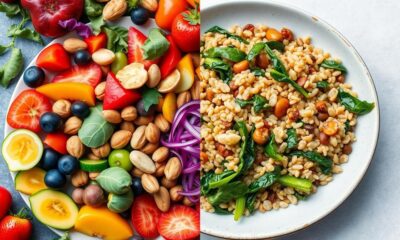
 Raw Food Recipes2 months ago
Raw Food Recipes2 months agoRaw Food Vs. Vegan: Which Diet Is Better?
-

 Raw Food Recipes2 months ago
Raw Food Recipes2 months agoIs Raw Food Good for Cats? Find Out Here
-

 Raw Food Recipes2 months ago
Raw Food Recipes2 months agoWhat Is the Raw Food Diet? A Comprehensive Overview





